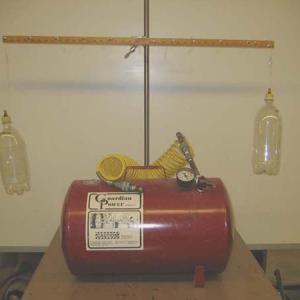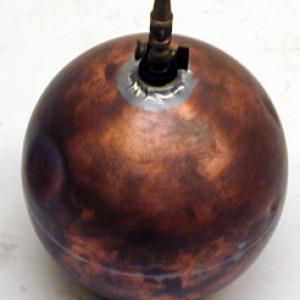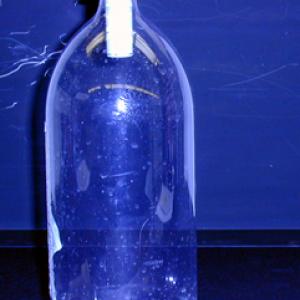College of Liberal Arts & Sciences
2B40.45 - Gas Law - Weight of Air Globe
The two bottles should balance when placed on the ends of the balance beam. Place about 45 lbs. of air into the air pig. Then, blow up one of the bottles to 45 lbs. The balance beam will show that the bottle you put the extra air into is now much heavier than the other bottle. If done as directed above, the bottle that you put the extra air into should have 4 times the air mass as the other bottle. You can also weigh the bottles directly on a digital balance and show the additional mass of air.
The weight of air globe has a constant volume. After evacuation the globe is weighed. The globe then may be filled with air or some pure gas and re-weighed. Different weights should be observed for each specific gas.
- Paul Hewitt, "Figuring Physics - Crushed-Can Weight", TPT, Vol. 52, # 8, Nov. 2014, p. 456.
- Anthony C. Zable, "Experiments with Helium-Filled Balloons", TPT, Vol. 48, # 9, December 2010, p. 582.
- G. Calzà, L.M. Gratton, T. López-Arias, and S. Oss, "Measuring Air Density in the Introductory Lab", TPT, Vol. 48, # 3, March 2010, p. 189.
- Figuring Physics, TPT, Vol. 45, # 1, Jan. 2007, p. 49.
- Mark Talmage Graham, "Investigating Gases' Masses in Impecunious Classes", TPT, Vol. 40, # 3, p. 144, March 2002.
- Jolene Houser, Doug Johnson, and Peter Siegel, "Getting Pumped Up on the Ideal Gas Law", TPT, Vol. 40, # 7, p. 396, Oct 2002.
- "Figuring Physics", TPT, Vol. 39, # 7, Oct. 2001, p. 410.
- Loren M. Winters, "A Photogate Flash Trigger and a Demonstration of Inertia", TPT, Vol. 30, # 7, Oct. 1992, p. 411.
- Michael D. Edmiston, "Agitation Solution", TPT, Vol. 30, # 6, p. 325, September 1992.
- Charles Parsons, " More Agitation than Solution", TPT, Vol. 30, # 6, p. 325, Sept. 1992.
- Robert G. Buschauer, "An Alternative Way to Measure Air Density", TPT, Vol. 29, # 2, Feb. 1991, p. 115.
- Se-yuen Mak and Zhu E-Qing, "A Quick Method to Measure the Density of Air", TPT, Vol. 28, # 6, p. 406, September 1990.
- Howard Brody, "An Experiment to Measure the Density of Air", TPT, Vol. 27, # 1, p. 46, January 1989.
- "Figuring Physics", TPT, Vol. 27, # 5, May 1989, p. 410.
- David M. Pope, "The Last Round Up: Eggs' Mass vs. Refrigerator's Air Mass", TPT, Vol. 27, # 6, Sept. 1989, p. 581.
- Albert W. Burgstahler, Tom Wandless, and Clark E. Bricker. "The Relative Lifting Power of Hydrogen and Helium", TPT, Vol. 25, # 7, p. 434, October 1987.
- Herbert E. Steingass, "Density of Air: Boiling Point of Water", TPT, Vol. 19, # 5, May 1981, p. 334.
- Maureen M. Julian, "Composition of Air: Further Calculations", TPT, Vol. 19, # 6, Sept. 1981, p. 362.
- Peter J. Brancazio, Howard Brody, "How Much Air is in a Basketball?", AJP, Vol. 55, # 3, March 1987, p. 276.
- Thomas B. Greenslade, Jr., "Vacuum Pump (Photo)", AJP, Vol. 70, # 12, Dec. 2002, p. 1193.
- F-115: "Bag of Gas", DICK and RAE Physics Demo Notebook.
- M- 22a: Wallace A. Hilton, "Density of Air", Physics Demonstration Experiments.
- Robert Ehrlich, "8.13, Finding the Mass of Air Inside a Balloon", Why Toast Lands Jelly-Side Down, p. 136.
- George M. Hopkins, "Weighing Gases", Experimental Science, p. 86.
- R. W. Pohl, "11. Gases and Vapors as Fluids with a Low Density and no Surface", Physical Principles of Mechanics and Acoustics, p. 175.
- Charles Vivian, "Compressing Air under Water", Science Experiments & Amusements For Children, p. 78
- Julien Clinton Sprott, "2.17, Weight of Air", Physics Demonstrations, p. 111, ISBN 0-299-21580-6.
- Robert Ehrlich, "6.10 - Weighing a Balloon When Filled and Empty", Why Toast Lands Jelly-Side Down, p. 111-112.
- Janice VanCleave, "Tip", Earth Science for Every Kid - 101 Easy Experiments That Really Work, p. 122-123.
- "Does Gas Have Mass?", The Caliper, Vol. 21, # 2, Fall 2004, p. 7, Vernier Software and Technology.
- Bobby Mercer, "Air is Heavy", Junk Drawer Chemistry, 2016, p.3.
- "Flask for Weighing Air", Pike's Illustrated Catalogue of Scientific & Medical Instruments, 1984, p. 212.
- The Queen Catalogues Vol. II, Catalogue of Physical Instruments, No. 2496, p. 33.
Disclaimer: These demonstrations are provided only for illustrative use by persons affiliated with The University of Iowa and only under the direction of a trained instructor or physicist. The University of Iowa is not responsible for demonstrations performed by those using their own equipment or who choose to use this reference material for their own purpose. The demonstrations included here are within the public domain and can be found in materials contained in libraries, bookstores, and through electronic sources. Performing all or any portion of any of these demonstrations, with or without revisions not depicted here entails inherent risks. These risks include, without limitation, bodily injury (and possibly death), including risks to health that may be temporary or permanent and that may exacerbate a pre-existing medical condition; and property loss or damage. Anyone performing any part of these demonstrations, even with revisions, knowingly and voluntarily assumes all risks associated with them.


